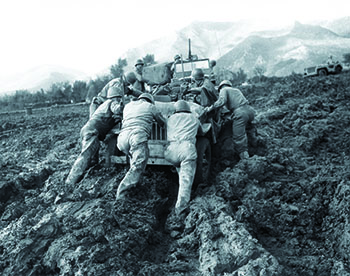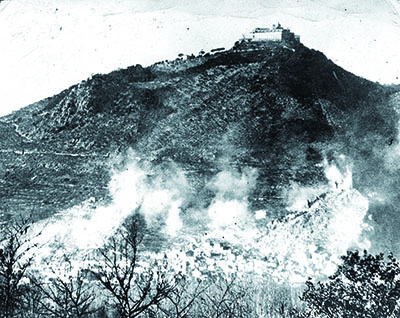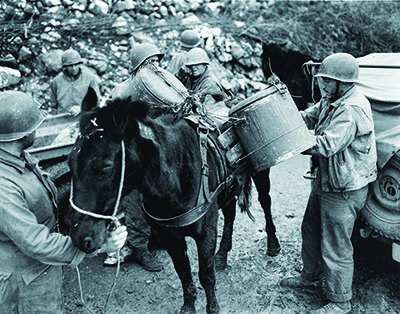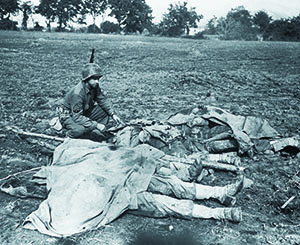[dropcap]T[/dropcap]he U.S. Army called them “morale crates,” and they were shipped to arrive in Italy in time for Christmas to raise the spirits of the troops. Morale specialists in the War Department in Washington had carefully selected each item to provide the soldiers with fun diversions from the mud, cold, sleet, rain, and, of course, the Germans who were trying to kill them every day and often succeeding.
It soon became apparent that the specialists had no idea what combat was like in Italy in 1943. One crate contained 258 ping-pong balls—not quite what the frontline troops needed for a change of activity. The crate also held wrestling mats and boxing gloves. There were makeup kits and a variety of costumes, both male and female. Apparently, someone had thought that holding variety shows and boxing and wrestling matches would improve the mood of the GIs.
Another morale crate contained tennis rackets and phonograph records, which were well received by those in rear-echelon areas, where the sounds of bouncing tennis balls and American music would not invite German artillery fire. These items were not a big hit with troops on the frontlines, however, and only added to the futility and desperation of their plight as they battled a host of enemies—only some of them the Germans.
“THE WAY WAS CRUEL,” wrote Pulitzer Prize-winning war correspondent Ernie Pyle. “Our troops were living in almost inconceivable misery.” Pyle knew because he was in Italy with them, in the knee-deep mud and freezing cold and snow. “Thousands of men had not been dry in weeks. They looked like men of prehistoric times.”

The Americans that winter faced a lot more than the awful weather. They were positioned along the Gustav Line—a heavily fortified line of German defenses that stretched 100 miles across central Italy from the Adriatic to the Tyrrhenian Sea. The line’s strongest point was at Monte Cassino, a 1,706-foot hill just 80 miles southeast of Rome. The men could clearly see what awaited them ahead. They were to head northwest across the swollen, 50-foot-wide Rapido River, take the hill, and break through the German line to reach Route 6, the all-important highway to Rome.
The men also knew from intelligence reports and their own observations that the Germans had placed thousands of mines along both sides of the river, and—on the Germans’ side—prepared a ring of dugouts, trenches, concrete and steel bunkers, and machine-gun nests, all behind a double line of barbed wire. The enemy had also enlarged and strengthened caves in the steep hillsides that faced the Americans, emplaced more steel bunkers, and sited their machine guns in such a way that the fields of fire would interlock, leaving not so much as a square foot of safe ground.
In addition, around Monte Cassino, the Germans had dug more caves for use as firing points and observation posts, so that they could track every movement of the American army in the valley below them. Atop the hill, a large, ancient abbey stood, overlooking the surrounding area.
“Like a lion it crouched,” wrote Lieutenant Harold Bond, a rookie replacement in the American 36th Infantry Division, describing the first time he saw the abbey, “dominating all approaches, watching every move made by the armies below. It was a strange feeling to know that the men up there, watching our movements through field glasses, could, if they thought us worth the trouble, bring down terrible artillery fire on our heads.”

The Germans, though, were not using the abbey to observe the Americans. German general Fridolin von Senger und Etterlin, the commander of the region, had forbidden its use by his men—an order strictly obeyed. The general was a devout Catholic and didn’t want to see the abbey damaged. But there were practical considerations as well: “so conspicuous a landmark would be quite unsuitable as an observation post,” Etterlin explained in his memoirs. Instead, the Germans built their observation posts up to the base of the huge structure; from there, they could see everything they needed to see.
German forces had also blown up the nearby town of Cassino, at the bottom of the hill, destroying it house by house in order to make another impregnable fortress out of the rubble. They had learned from fighting in Stalingrad that reducing buildings to ruins made far more effective defensive positions than leaving them intact.
The area’s natural terrain presented its own challenges. To the Americans and their allies fighting their way north from the boot of Italy over the past months, it seemed that the country consisted of an endless series of valleys and mountain ranges, some as high as 5,000 feet. The men would fight their way to the top of one mountain only to see more mountains in the distance.
The roads through them were rough, crude, and only one lane wide, and snaked through narrow canyons and along the edges of cliffs, leaving vehicles only inches away from falling into an abyss. Most roads were unsuitable for trucks, even on dry days without the constant rain, and so supplies had to be hauled up by long trains of pack mules.
Some of the trails were too steep or rugged even for the mules, leaving troops to carry their own supplies—the weapons, ammunition, food, and water vital to their survival. And the wounded and dead had to be carried down the mountains, where it could take up to four hours to reach the bottom, often too long to get medical care for an injured soldier.
There were also weeks and weeks of rain, torrents of water falling day and night. Conditions were as miserable for the troops in the valleys as they were for those clinging to life on the steep hillsides; the heavy downpours turned the dirt into gooey sludge, thick enough to pull off a soldier’s boots as he tried to advance. When trucks attempted to cross through the muck or over rivers and streams, fast-flowing waters often swept them away.
Supply dumps and field hospitals became seas of mud. Gale-force winds screamed down the mountainsides and blew away the tents of operating rooms and hospital wards. Nothing was spared; no one was safe.

It became impossible for the troops, living in water-filled foxholes, to keep their feet dry. Trench foot became common; feet swelled up to four times their normal size. Men often had to cut off their boots with knives, and many developed gangrene and had to have toes amputated to prevent the infection from spreading up their legs.
Most of the men on the frontlines that winter—particularly those in the American 34th and 36th infantry divisions—had been in combat for four months and had suffered staggering casualties. Many companies had lost up to 60 percent of their original numbers, and three out of four new lieutenants—the so-called “90-Day Wonders,” straight out of officer training schools—were replacements.
“We were no longer a team,” said a captain with the 36th Division. “It was hard to develop confidence and trust in the soldier you shared a foxhole with if you did not know him; if you had not fought together.”
As winter wore on and Christmastime approached, the losses mounted from enemy action, trench foot, and disease—including a deadly typhus epidemic—and a growing number of mental breakdowns. The war of attrition reduced some companies to little more than 25 men out of a normal complement of up to 250.
By Christmas week, the U.S. Army in Italy had suffered 40,000 battle casualties over the previous four months. Another 50,000 men were disabled by illness, and about 20,000 had deserted. Among those still on the frontline, there was an increasing level of hopelessness and despair.
Some were so desperate to leave that they shot themselves. “Men maim themselves, blow off toes and stuff like that,” Lieutenant Bill Everett of the 36th recalled in a 2000 interview. “They just lost it. We used to say, ‘Every man has a string so long. You don’t know how long yours is. I don’t know how long mine is.’” Everett described people “who would blow their fingers off with an M-1. You can imagine what that does. It blows the rest of the hand off. They’re under stress.”
Ernie Pyle saw it in their faces. “It’s a look of dullness, eyes that look without seeing,” the journalist reported, and it reflected “exhaustion, lack of sleep, tension for too long, weariness that is too great, fear beyond fear, misery to the point of numbness, a look of surpassing indifference to anything anybody can do. It’s a look I dread to see on men.”
Another war correspondent, acclaimed photojournalist Margaret Bourke-White, captured the same looks of anguish. She wrote about “the deathly strain on their faces, the growing numbness that enveloped them like a shroud. This numbness was their only defense against an anxiety that had become intolerable. To live in a state of mental paralysis was the only way they could stand it. The men were so tired that it was like a living death.”
CHRISTMAS DAY 1943 provided no relief to those fighting against the Gustav Line. One survivor of the 36th Division remembered spending Christmas collecting the bodies of the dead men from his group and trying to identify them. A company clerk spent the holiday searching through piles of Christmas packages addressed to those who had been killed; he would print the letters “KIA” on each one he found so that it could be returned to the sender.
Often, loved ones would send presents that bewildered the troops. The packages typically contained perishable food, which had rotted along the way, and unnecessary clothing such as polka-dotted neckties, ironed white dress shirts, silk socks, bathrobes, bedroom slippers, even colognes and aftershave lotion.

The only positive thing some men recalled about the holiday was that they did not receive their much-touted and highly publicized Christmas dinners with all the trimmings. The army had shipped enough turkey dinners to feed every American serving in Italy. But as Fred Sheehan, a rifleman in the 34th Division, described it, “The traditional Christmas feast left something to be desired. It was a long way from the turkey farms in the United States to the frontlines. Somewhere along the way refrigeration had broken down. What had been meant as a holiday treat developed into gastric distress.”
The troops near the Gustav Line were the only ones who did not receive those Christmas dinners. They were left with just K-rations in their muddy foxholes, but that turned out to be their only lucky break. Those who ate the holiday dinners were sick with dysentery for days afterward.
On December 26, 1943, Major General Fred L. Walker, commander of the 36th Division, summed up the feelings of every man on the line when he wrote in his diary, “Yesterday was not a very merry Christmas.” And the New Year would be even worse. ✯
This story was originally published in the December 2017 issue of World War II magazine. Subscribe here.





